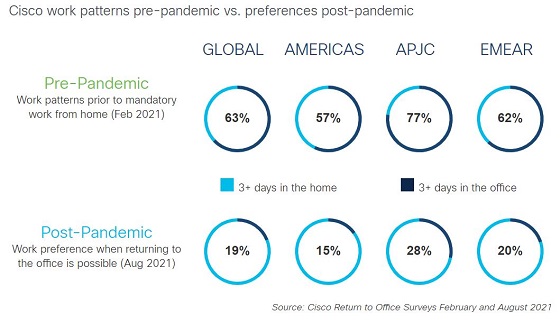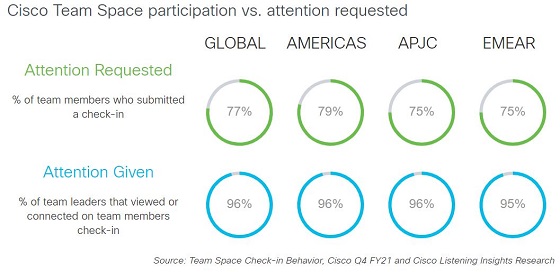Factors for success in the new era of hybrid work
We are at a critical juncture in the evolution of business and work. After almost a year of concerted vaccination programs throughout the developing world, COVID is shifting from a pandemic to being endemic, still likely to be present indefinitely, but contained and allowing us to resume relatively normal lives.
This is leading to a gradual—or sometimes rapid—resumption of office-based work. A minority of organizations appear to be intent on reverting to work structures very similar to those before the pandemic, with standard office hours, five days a week the norm. That is an enormous missed opportunity. This is a time to move forward rather than look back.
The opportunity to forge a better future of work
One of the massive silver linings of the immense disruption we’ve experienced is that it allows us to question the assumptions that underpinned how things used to be. Rather than simply assuming that previous practices were ideal, we can pull back to consider what is the best way to configure work for our unique organization. That endeavor is vastly helped by the ‘grand experiment’ of work during the pandemic, in which every organization went through a sudden shift to extensive remote work, being forced to learn how to make it work at least reasonably well.
In short, both workers and organizations experienced that there were benefits from distributed work, often more than they expected. At the same time there is clearly still great value from being in the same place as your colleagues at times, to build trust, collaborate closely, and perhaps most importantly, appreciate the pleasure of human connection which has been sorely lacking for so long.
This means we have now entered a new era of hybrid work. Virtually every organization is seeking to understand and implement the optimal combination of office and remote work to support their employees and achieve their mission. The opportunity is to use the time that people are in the office to fullest possible advantage, building trust, rapport, and social connection, integrated with the best use of time at home or coworking spaces for focused project work. Hybrid work at its best can far outperform either fully office-based or fully remote work. We just need to design it well.
Tracking the progress of hybrid work
It is timely to examine in detail how organizations are shifting from their pandemic work arrangements to establish the best possible hybrid work structures. Fortunately Cisco has just released its Hybrid Work Index, which provides a detailed global view of the evolution of hybrid work. It will be updated quarterly, allowing leaders to understand what other companies are doing and lessons learned along the way. The full insights in the Hybrid Work Index are well worth spending the time to explore. I will highlight a few of the specific insights to help explore how we can best implement hybrid work.
Perhaps the most important lesson from the pandemic is that now employees have experienced working from home, many are unequivocally expressing their preference do so a significant proportion of the time. As many as 80% want to work from the office two days or less each week, as shown in the data below. Staff have experienced the many benefits of remote work, including greater work flexibility as well as eliminating the time and annoyance of commuting.

Source: Cisco Hybrid Work Index
Employee engagement
One of the greatest challenges of remote work is that workers often experience being less engaged. They frequently have little informal connection with their managers and colleagues, with most interaction during goal-oriented team meetings. It is far harder to build a powerful company culture when people are not physically in the same place.
This means one of the primary functions of visiting offices is to build engagement with colleagues and the company. Yet there is much that leaders can do to maximize engagement even when people work largely remotely. It requires new work practices and leadership styles. At Cisco team members are actively encouraged to check in with requests for attention, given the proven link to engagement and performance. At all times leaders need to be sensitive not just to requests, but also to the unexpressed needs of their staff. Given limited face-to-face interaction, the value of this attention can be disproportionate in driving positive engagement.

Source: Cisco Hybrid Work Index
What has also been clearly demonstrated is that engagement is being increasingly driven by employees’ feeling of alignment with their employers’ purpose and impact. As the United Nations COP26 conference in Glasgow gets underway (incidentally supported by Cisco to enable an inclusive experience), sentiment about action on climate change is at a global all-time high.
We will of course continue to travel for work, both locally to offices and nationally and beyond for meetings. Yet much travel and its associated carbon emissions are unnecessary. Those organizations that strive to optimize hybrid work will inevitably be improving their impact and attracting the support of their staff.
Next-generation online meetings
For many over the last 18 months, overexposure to video on flat screens has been challenging. We can now anticipate a next generation of online meetings that far transcend the experience of traditional video calls. Among the raft of innovations announced at the WebexOne conference this week was Webex Hologram, an exciting technology using augmented reality to make others appear as if they are in the same room as you.
This announcement paves the way to far more immersive and engaging ways for us to communicate remotely. In coming years rapidly advancing meeting technologies will make the experiences of in-person and virtual meetings feel increasingly similar. Check out the video of Webex Hologram below for a sense of what is already here.
Inclusive work practices
One of the most critical issues for any organization is inclusiveness, not just in the culture and diversity of employees, but also in everyday work practices. We all understand that diversity in people’s characteristics and cognitive styles is essential. We also need to ensure that a wide range of distinctive views are actively incorporated into discussions and decisions.
The reality is that participation in physical meetings is often skewed to a minority of those present, with some voices simply not heard. Unfortunately the dynamics of online meetings, especially when some are present in the office with others remote, can significantly accentuate this pernicious dynamic. Cisco’s extensive data from over 600 million meeting participants shows that almost half of those present are not speaking in any given meeting.

Source: Cisco Hybrid Work Index
This is major problem, meaning not just that voices are excluded, but also that some people inevitably feel less engaged. While sometimes time constraints and meeting size mean not everyone can participate, there are important measures to take to ensure the fullest possible engagement.
On the technology front, meeting analytics can draw managers’ attention to imbalanced participation, and tools such as polls, Q&A, and whiteboarding can enable broader engagement. Real-time transcription and translation can substantially assist non-native speakers to follow what is happening, feel engaged, and speak up. Meeting transcription can allow people who do not need to be present in meetings to be productive in other ways and catch up later on what happened.
This goes to some of the broader shifts in work practices that a world of hybrid work entails. Managers need to think differently about the role of meetings to ensure that people are not overloaded by back-to-back meetings which many find to be minimally productive. The best completely virtual organizations in the world shift work as much as possible from synchronous (i.e. meetings) to asynchronous styles, in which most work can be done in collaborative documents and workflow.
Productivity and wellbeing
At the outset of the shift to remote work the concern of many managers was that workers would not be productive when working unsupervised at home amid distractions. Extensive data has shown that the opposite is often true, including one Stanford professor’s study showing a 13% increase in performance for those working from home.
Depending on their home working situation, staff can find that in fact they are better able to block out undistracted time for tasks that require focus, especially if their office environment is open plan. However everyone is different in their work preferences. The unparalleled opportunity from hybrid work is that people increasingly have choices in where they work, which they can select depending on what they are working on.
Days at home can be largely dedicated to focus work. Mondays and Fridays are commonly used for working from home, with some companies banning meetings on at least one of those days so people’s attention is not continually being broken.
Many have experienced a negative impact on their mental and physical wellbeing during full-time remote work. This must be taken into account in work design, with teams establishing structures that function best for their responsibilities and working styles. Pepsico’s ‘Work That Works’ program allows teams to choose how they do their work to suit them, with no default daily workplace. In some cases working from an office is what people need to enjoy human company and get welcome variety and stimulation in their lives, as well as to build productive relationships with colleagues.
Creating the future of hybrid work
This is a time of possibility, of being able to innovate in creating the work structures that work best for people, organizations, and the planet. We are on an extended journey to optimize this new phase of hybrid work, but we can be sure that it will be better than anything we’ve ever experienced before. It’s time to bring together the best of all possible work worlds to seize the potential of this new era of hybrid work.



